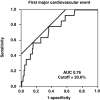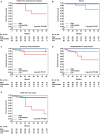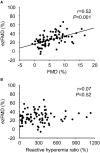Endothelial Function Assessed by Automatic Measurement of Enclosed Zone Flow-Mediated Vasodilation Using an Oscillometric Method Is an Independent Predictor of Cardiovascular Events
- PMID: 28003249
- PMCID: PMC5210444
- DOI: 10.1161/JAHA.116.004385
Endothelial Function Assessed by Automatic Measurement of Enclosed Zone Flow-Mediated Vasodilation Using an Oscillometric Method Is an Independent Predictor of Cardiovascular Events
Abstract
Background: A new device for automatic measurement of flow-mediated vasodilation (FMD) using an oscillometric method has been developed to solve technical problems of conventional FMD measurement. This device measures enclosed zone FMD (ezFMD). The purpose of this study was to evaluate the prognostic value of endothelial function assessed by ezFMD for future cardiovascular events.
Methods and results: We measured ezFMD in 272 participants who underwent health-screening examinations. First, we investigated cross-sectional associations between ezFMD and cardiovascular risk factors, and then we assessed the associations between ezFMD and first major cardiovascular events (death from cardiovascular causes, stroke, and coronary revascularization). Univariate regression analysis revealed that ezFMD was significantly correlated with age, triglycerides, glucose, smoking pack-years, estimated glomerular filtration rate, high-sensitivity C-reactive protein, and Framingham risk score. During a median follow-up period of 36.1 months (interquartile range 18.8-40.1 months), 12 participants died (6 from cardiovascular causes), 3 had stroke, 8 had coronary revascularization, and 10 were hospitalized for heart failure. There was no episode of acute coronary syndrome during the study period. Participants were divided into tertiles (low, intermediate, and high) based on ezFMD. Kaplan-Meier curves for first major cardiovascular events among the 3 groups were significantly different (P=0.004). After adjustment for cardiovascular risk factors, the low group was significantly associated with an increased risk of first major cardiovascular events compared with the high group (hazard ratio 6.47; 95% CI 1.09-125.55; P=0.038).
Conclusions: These findings suggest that endothelial function assessed by ezFMD may be useful as a surrogate marker of future cardiovascular events.
Clinical trial registration: URL: https://upload.umin.ac.jp. Unique identifier: UMIN000004902.
Keywords: atherosclerosis; biomarker; cardiovascular events; endothelial function.
© 2016 The Authors. Published on behalf of the American Heart Association, Inc., by Wiley Blackwell.
Figures





Similar articles
-
A novel noninvasive and simple method for assessment of endothelial function: enclosed zone flow-mediated vasodilation (ezFMD) using an oscillation amplitude measurement.Atherosclerosis. 2013 Aug;229(2):324-30. doi: 10.1016/j.atherosclerosis.2013.05.016. Epub 2013 Jun 6. Atherosclerosis. 2013. PMID: 23880183 Clinical Trial.
-
Usefulness of brachial artery flow-mediated dilation to predict long-term cardiovascular events in subjects without heart disease.Am J Cardiol. 2014 Jan 1;113(1):162-7. doi: 10.1016/j.amjcard.2013.08.051. Epub 2013 Oct 5. Am J Cardiol. 2014. PMID: 24169007
-
Combined use of endothelial function assessed by brachial ultrasound and high-sensitive C-reactive protein in predicting cardiovascular events.Clin Cardiol. 2007 Mar;30(3):135-40. doi: 10.1002/clc.20058. Clin Cardiol. 2007. PMID: 17385705 Free PMC article.
-
Is impaired flow-mediated dilatation of the brachial artery a cardiovascular risk factor?Curr Vasc Pharmacol. 2003 Jun;1(2):107-9. doi: 10.2174/1570161033476745. Curr Vasc Pharmacol. 2003. PMID: 15320837 Review.
-
[Brachial arterial flow mediated dilation: utility in clinical and experimental practice].Rev Neurol. 2011 Sep 16;53(6):351-60. Rev Neurol. 2011. PMID: 21894606 Review. Spanish.
Cited by
-
Vascular endothelial function and its response to moderate-intensity aerobic exercise in trained and untrained healthy young men.Sci Rep. 2024 Sep 3;14(1):20450. doi: 10.1038/s41598-024-71471-7. Sci Rep. 2024. PMID: 39242762 Free PMC article.
-
The effect of periodontal treatments on endothelial function in degrees of periodontitis patients: A systematic review and meta-analysis.PLoS One. 2024 Sep 19;19(9):e0308793. doi: 10.1371/journal.pone.0308793. eCollection 2024. PLoS One. 2024. PMID: 39298393 Free PMC article.
-
Peripheral arterial elasticity changes derived by volume-oscillometry in reaction to hyperemia as a possible assessment of flow-mediated vasodilatation.Sci Rep. 2022 Nov 14;12(1):19479. doi: 10.1038/s41598-022-22050-1. Sci Rep. 2022. PMID: 36376342 Free PMC article.
-
Assessment of Lower-limb Vascular Endothelial Function Based on Enclosed Zone Flow-mediated Dilation.Sci Rep. 2018 Jun 18;8(1):9263. doi: 10.1038/s41598-018-27392-3. Sci Rep. 2018. PMID: 29915185 Free PMC article.
-
Coffee and Endothelial Function: A Coffee Paradox?Nutrients. 2019 Sep 4;11(9):2104. doi: 10.3390/nu11092104. Nutrients. 2019. PMID: 31487926 Free PMC article. Review.
References
-
- Ross R. Atherosclerosis‐an inflammatory disease. N Engl J Med. 1999;340:115–126. - PubMed
-
- Higashi Y, Noma K, Yoshizumi M, Kihara Y. Oxidative stress and endothelial function in cardiovascular diseases. Circ J. 2009;73:411–418. - PubMed
-
- Panza JA, Quyyumi AA, Brush JE Jr, Epstein SE. Abnormal endothelium‐dependent vascular relaxation in patients with essential hypertension. N Engl J Med. 1990;323:22–27. - PubMed
-
- Celermajer DS, Sorensen KE, Gooch VM, Spiegelhalter DJ, Miller OI, Sullivan ID, Lloyd JK, Deanfield JE. Non‐invasive detection of endothelial dysfunction in children and adults at risk of atherosclerosis. Lancet. 1992;340:1111–1115. - PubMed
-
- Corretti MC, Anderson TJ, Benjamin EJ, Celermajer D, Charbonneau F, Creager MA, Deanfield J, Drexler H, Gerhard‐Herman M, Herrington D, Vallance P, Vita J, Vogel R; International Brachial Artery Reactivity Task Force . Guidelines for the ultrasound assessment of endothelial‐dependent flow‐mediated vasodilation of the brachial artery: a report of the International Brachial Artery Reactivity Task Force. J Am Coll Cardiol. 2002;39:257–265. - PubMed
Publication types
MeSH terms
Associated data
- Actions
LinkOut - more resources
Full Text Sources
Other Literature Sources
Research Materials

